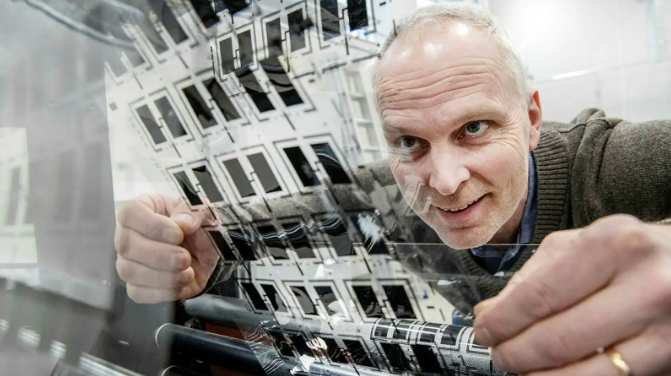Organic materials rises against lithium in the batteries of the future – Article in Dagens Industri

Peter Ringstad places something that resembles a sticker in his mouth. It almost looks like he’s trying to scrape off melted chocolate from a candy wrapper.
“It has a safe battery chemistry. You can chew on it without ingesting anything harmful, unlike a lithium cell,” he says.
What he’s biting into is actually a thin plastic film with a small battery layer. Together with a layer of solar film, this is one of Ligna Energy’s first products that can both generate and store energy. Now, the battery cell is being delivered to several customers to verify its practical functionality.
“We have a unique recipe for the materials in our batteries. One of the components in our batteries is natural waste products. We reuse things that are usually discarded or burned as biofuel,” says Peter Ringstad.
The main ingredient at Ligna Energy is lignin, a byproduct from the wood and paper industry, which replaces lithium and lead. This is something the company believes is more sustainable because it facilitates recycling and does not lead to the same depletion of Earth’s resources.
The technology was developed at Linköping University. After a decade of research, professors Magnus Berggren, Xavier Crispin, and Olle Inganäs chose to take the next step in finding practical applications. In 2017, the trio founded Ligna Energy and brought in Peter Ringstad as the company’s first full-time employee.
“It was five years ago that we reached a level of maturity where we could begin commercializing the technology, developing products, and identifying potential markets,” he says.
The researchers themselves have not taken active roles in the company. It is Peter Ringstad and the other members of the leadership team who have shaped its development. This may have facilitated when research aspects needed to be prioritized over other factors.
“Our major challenge has been choosing to exclude certain ideas. One needs to be rational about decisions regarding technology and research. The cost aspects have required some discipline, and we have needed to consider the needs of potential customers and balance the commercial aspects with technology development,” he says.
One example is that the company initially focused on large-scale energy storage, something they had to steer away from for practical reasons.
“We faced a decision where we had to choose which segment we had the best chance of success in. To build a company, you need to chart the journey to a point where you start generating revenue that makes sense to investors. Two years ago, we decided that the best path was to mass-produce smaller components,” says Peter Ringstad.
So far, it has worked out well. The company raised 13 million SEK from investors last spring and has attracted a total of around 30 million SEK. And interest hasn’t waned despite tougher economic times.
“We are currently in a new funding round where we aim to raise approximately 30-40 million SEK. And the dialogue with investors looks promising, despite the economic situation worldwide. We combine ‘deep tech’ and sustainability, and there is a stable investor interest in both areas,” says Peter Ringstad.
The company does not expect significant revenue until next year. Right now, the focus is on building production capacity to be ready to deliver as soon as current test customers verify that the batteries work in their electronic products.
“We recently purchased our first large production machine. It will increase our production capacity from about 5,000 components per year to half a million. We will be ready to start securing major sales contracts in 2024.”
If necessary, the operation can be scaled up even further.
“It’s just a matter of buying another production line and producing more. In five years, we have the potential to be a profitable company of 50 employees with good margins, selling 20 million units per year. But we can also produce 100 million units. There is nothing but our production capacity that sets the limits.”
It is also not impossible that in the future, they will return to the original idea of selling larger energy storage solutions.
“It would require billion-dollar financing and a more radical structure for the company. But the potential to sell large-scale energy storage to energy parks and properties is significant. Then we would have truly created a large company.”




